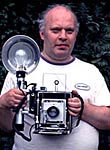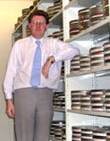|
|
 
|
|
Author
|
Topic: The Tales of Hoffmann (1951) 4k restoration.
|
|
|
|
|
Stephen Furley
Film God

Posts: 3059
From: Coulsdon, Croydon, England
Registered: May 2002
|
 posted 04-26-2015 04:43 AM
posted 04-26-2015 04:43 AM




Jonathan,did you see it in 2k or 4k?
I saw it in 2k yesterday afternoon and I pretty much agree with what you think about both picture and sound. Apart from what I think must be the scene you mentioned there were a couple of others, but they weren't as noticeable.
As for the sound, it wasn't great, but they were 1951 recordings. They were Western Electric, which I think means VD,doesn't it? They sounded to me as if they may have been rerecorded at some time before they were eventually digitised. This film was from the same year as the final version of Show Boat. The notes from the Laserdisc version of that film say that it was from a period of transition; some of the earliest elements were nitrate, while most were triacetate. Also, while most of the original sound recordings were optical some of the music was magnetic. I don't think that was the case here; it all sounded like pure optical sound.
The picture generally looked very good, probably the best digital restoration that I've seen.
| IP: Logged
|
|
|
|
Leo Enticknap
Film God

Posts: 7474
From: Loma Linda, CA
Registered: Jul 2000
|
 posted 04-27-2015 12:14 PM
posted 04-27-2015 12:14 PM





quote: Stephen Furley
As for the sound, it wasn't great, but they were 1951 recordings. They were Western Electric, which I think means VD,doesn't it?
Assuming that Western Electric sound cameras were used to make the final mix track negs, yes.
The two competing systems of that day were effectively Western Electric (VD) and RCA (the bogstandard system was dual bilateral VA, but there was also a more expensive system, with slightly more headroom - I think 9.5KHz as distinct from 8, that used ultra-violet light in the sound camera, UV-sensitized negative stock only and a single bilateral track looking like it was printed inverse, nicknamed "RCA Duplex". The UV stock prevented beam spread where the dark meets the light and increased the signal-to-noise ratio, too - a sort of forerunner of hi-magenta and cyan tracks).
The Western Electric/VD system was more resilient against signal loss through multiple generations of duping, as long as the timing and processing of each element was very accurate. Even the slightest loss of contrast and gamma on a VD track caused the signal-to-noise ratio to fall off a cliff. RCA/VA, on the other hand, didn't provide quite as nice a sound at its best, but was more resilient to lab quality control not being as good as it could be. So it frequently happened that original (studio or location) recording and mixing was done using the Western Electric system, and then as a final step, the final mix track negs used for the release prints would be RCA/VA. I have seen loads of prints of movies from around 1945-55 with Western Electric logos on the credits, but an RCA Duplex track on the actual print.
Also, if the projector has an exciter bulb that is on its last legs and has carbon blackening on the inside of the envelope (and thus a significant reduction in light output), that will degrade the signal from a VD track more than it will from a VA one. For all these reasons, VD tracks on release prints gradually fell out of favor as the '30s and '40s progressed, even though VD recording continued to be used in production and post-production for the better sound it delivered if VD was "done right".
In crude terms, the difference between VD and VA was a little bit like the difference between LPs and CDs: the former can sound amazingly good if attention to detail and quality control is applied at every stage of the technology's use, but it is not idiot- or penny pincher-proof. The latter will deliver a consistent and more reliable, though slighly lower quality, if you just thread up and press the button.
Of all the release print mono optical track types out there, RCA Duplex sounds the nicest to my subjective ears when played through modern equipment. The ground noise can be audible in quiet passages, but the payback for that is that you can hear detail in the HF that you can't on other types of VA and VD track. Women's voices don't sound as muffled, for example. If you have a CP200, the noisier RCA Duplex tracks can be quietened down a bit by playing them in 02, and I can't hear the signal suffering.
Anyway, none of this should matter in the case of this film, because reasonable sound elements must exist of it. I've shown a BFI 35mm print from its 1980s photochemical restoration of The Tales of Hoffman (though admittedly in the mid-90s), and it sounded fine to me. If there were any audible defects on this DCP, then the audio mastering of the DCP was screwed up and/or they did not use the best elements available.
As a sidebar, Hoffman must have been made right on the cusp of the change from optical to magnetic recording on the actual set.
| IP: Logged
|
|
|
|
All times are Central (GMT -6:00)
|
|
Powered by Infopop Corporation
UBB.classicTM
6.3.1.2
The Film-Tech Forums are designed for various members related to the cinema industry to express their opinions, viewpoints and testimonials on various products, services and events based upon speculation, personal knowledge and factual information through use, therefore all views represented here allow no liability upon the publishers of this web site and the owners of said views assume no liability for any ill will resulting from these postings. The posts made here are for educational as well as entertainment purposes and as such anyone viewing this portion of the website must accept these views as statements of the author of that opinion
and agrees to release the authors from any and all liability.
|

 Home
Home
 Products
Products
 Store
Store
 Forum
Forum
 Warehouse
Warehouse
 Contact Us
Contact Us




 Printer-friendly view of this topic
Printer-friendly view of this topic












